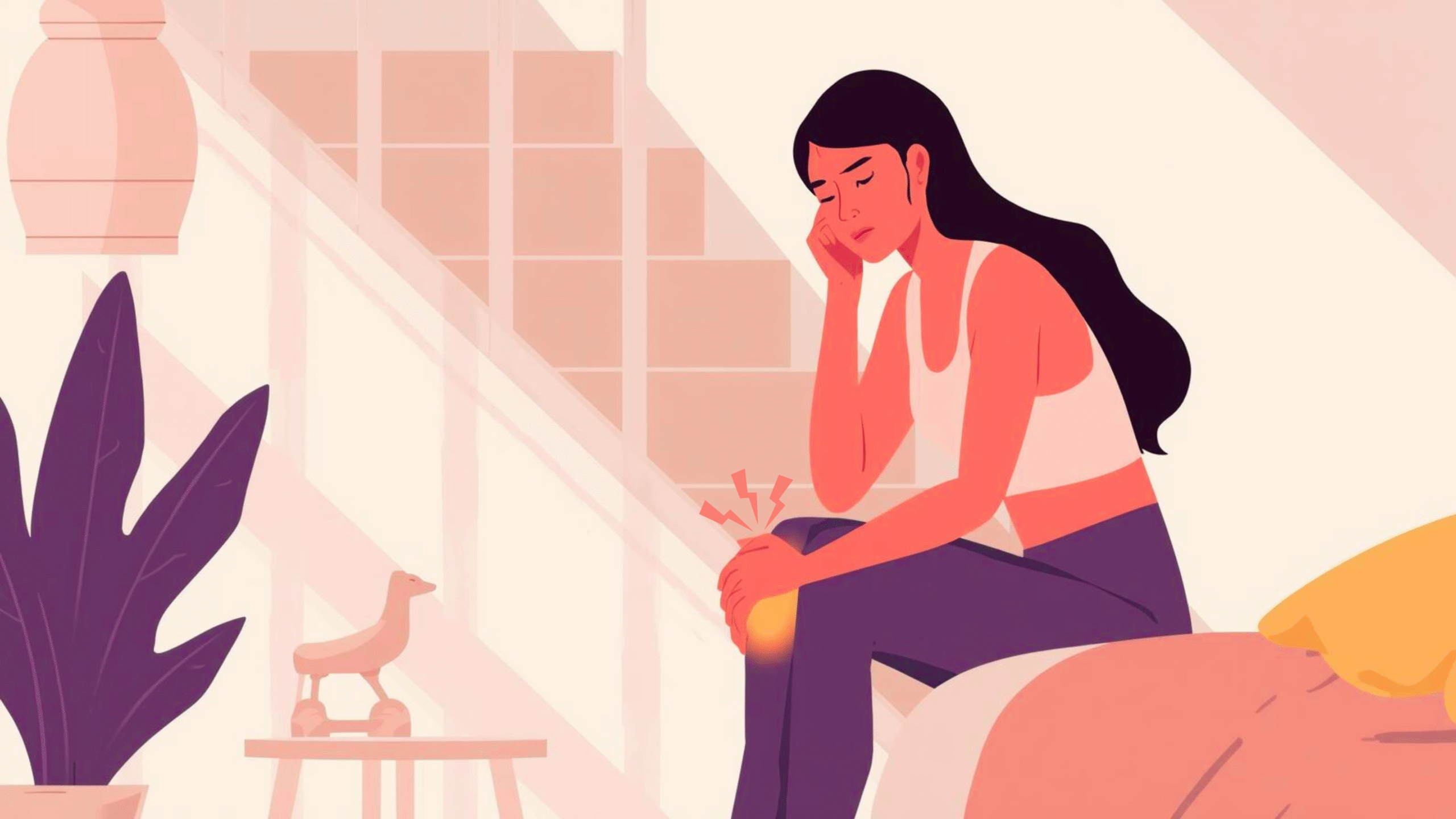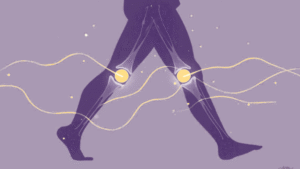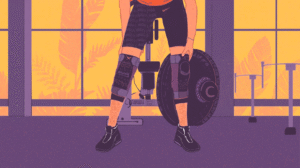You know that weird moment when you stand up after sitting too long and your knees make that crackle-pop symphony? You tell yourself it’s normal; maybe you just need to stretch, but your knees might be whispering something more serious.
The truth is, knee pain rarely appears overnight. It creeps in quietly, disguised as stiffness, a dull ache, or that “it’ll go away” discomfort after climbing stairs.
Before you scroll past this thinking, “I’m too young for knee problems,” remember, knees don’t care about your age; they care about how you treat them. So let’s decode the subtle signs your knees are asking for help before things get worse.
Morning Knee Stiffness: Why Your Joints Feel Rusty and How to Fix It
If your knees feel stiff every morning or after long sitting sessions, it might be more than just a “slept-wrong” situation. That stiffness is often an early sign of cartilage wear or inflammation around the joint capsule [1]. It’s your body’s way of saying the joint fluid isn’t circulating well, kind of like an engine running on old oil.
Why it matters:
When you move, your cartilage gets lubricated through a process called “synovial fluid diffusion.” If you’re sitting all day, your knees aren’t getting that nourishment. Over time, that leads to tightness and pain and early signs of knee damage you shouldn’t ignore.
Try this:
Incorporate gentle knee pain exercises like heel slides or mini squats every morning. Just 5–7 minutes of motion can boost joint lubrication and wake up those sleepy tendons [2].
Bonus Tip:
Next time you get up from bed and your knees creak like a door hinge, don’t panic. Just move around a bit. Your knees love circulation more than caffeine.
Knee Pain When Climbing Stairs? Here’s Why It Happens
You once used to take two steps of the stairs at a time. Now? Every step feels like a mini leg day. That fatigue or mild pain climbing stairs often hints at early muscle imbalances, especially weak quadriceps and glutes.
The science behind it:
Your knees rely on surrounding muscles to distribute force. When your quads, glutes, or hamstrings are undertrained, your knee joint takes the hit. Studies show that poor lower-limb strength increases compressive stress on the patella, accelerating wear and tear [3].
Prevention Tip:
Add simple daily exercises for healthy knees to your routine:
- Wall sits: Strengthen your quads and glutes without pressure on the knees.
- Step-ups: Great for balance and coordination.
- Bridge pose: Activates hamstrings and supports knee alignment.
Friendly Reminder:
If you avoid stairs to “save your knees,” you’re doing the opposite. Strength builds protection. Weak knees are usually the result of underuse, not overuse.
What That Tiny Knee Pop Really Means for Your Joint Health?

A soft click here, a pop there; not always bad news. But if it’s accompanied by pain or swelling, your knees might be signaling early wear or a cartilage issue [4].
Here’s what’s really happening:
- A painless pop usually means gas bubbles or tendon movement, which is normal.
- Painful or repeated clicking = possibly weakened ligaments or early cartilage thinning.
Think of it as your knee’s SOS message, a sound check that says, “I need some maintenance.”
Knee Pain Prevention Tip:
Do gentle strength-focused knee pain exercises such as:
- Straight leg raises for patellar stability.
- knee extensions to strengthen the joint.
- Foam rolling your quads and IT band to reduce pressure.
Pro Tip: Don’t dive straight into your workout cold. Your knees prefer a little warm-up foreplay before all that bending and flexing.
Changing the Way You Move? Early Sign of Knee Trouble
Ever noticed yourself favoring one leg over the other or adjusting how you sit, stand, or walk? That’s often an unconscious attempt to protect a weak or irritated knee. It might start small; maybe you shift your weight to one side while standing, but over time, these compensations can cause hip, back, or ankle issues [5].
Why it matters:
When your knee alignment changes, it disrupts the natural tracking of the patella (kneecap). That’s when issues like patellofemoral pain syndrome begin, a fancy term for “my knees hurt every time I move.”
Fix it before it worsens:
Start a knee care routine for beginners that includes:
- Gentle stretching: Focus on hamstrings, calves, and quads.
- Balance work: Try standing on one leg for 30 seconds (and yes, it’s harder than it sounds).
- Posture check: Keep your hips, knees, and feet aligned when standing.
If you’re walking like a penguin to avoid pain, your body’s compensating, not evolving. Let’s fix that before evolution gets ideas.
When Your Knees Ache After Rest: A Quiet Warning Sign
You’d think resting would make your knees feel better, but sometimes the ache intensifies after sitting too long or binge-watching an entire season. That’s because inactivity tightens the muscles supporting the knee, limits blood flow, and increases stiffness [6].
The paradox:
Lack of movement often causes more pain than movement itself. Research from the Arthritis Foundation shows that gentle, consistent activity improves knee comfort and reduces inflammation. [7]
What to do instead:
Follow a daily exercise routine for healthy knees that combines mobility and low-impact strength:
- Knee circles to lubricate the joints.
- Seated leg extensions to activate quads.
- Short walks every 45 minutes if you work at a desk.
Movement mantra:
Motion is lotion. The more you move; smartly, not excessively ; the happier your knees become.
Keep Your Knees Happy: Prevent Pain Before It Begins
Because we all are familiar with the fact that ‘Prevention is better (and cheaper) than cure’, here are a few knee pain prevention tips you can start today:
- Watch your weight: Every extra kilo adds roughly 4 kg of stress on your knees when walking.[8]
- Upgrade your footwear: Shoes with poor cushioning can affect alignment. Think of them as shock absorbers for your knees.
- Strengthen from the core: Strong abs and hips stabilize your entire kinetic chain which means happier knees.
- Don’t skip warm-ups: Cold starts are for engines, not bodies.
- Recover right: A post-workout stretch or light massage can do wonders.
And yes, knee pain exercises are not just for those already hurting. They’re for anyone who wants to keep walking, dancing, driving, or running pain-free for decades.
When to Seek Professional Help?
If your knee pain persists for more than two weeks, worsens with movement, or is accompanied by swelling, clicking, or heat, it’s time to get evaluated by a physiotherapist or orthopedic specialist. Early diagnosis can prevent long-term damage like osteoarthritis or ligament degeneration. [9]
Ignoring pain is not toughness; it’s just bad planning.
Key Takeaway: Your Knees Talk, So Listen Early
Your knees are not trying to ruin your life; they’re just asking for attention- politely at first. Those little signs? They’re your cue to move smarter, stretch regularly, and strengthen the muscles that support them.
Treat your knees like the partners they are, not background extras. Start small, stay consistent, and your future self (and knees) will thank you for it.
Betterhood says:
Don’t wait until climbing stairs feels like scaling Everest. Mix in a few knee pain exercises, slip on a comfy knee sleeve for extra support, and move with intention. Healthy knees don’t just happen; they’re earned, one smart (and supported) step at a time
Explore More Health & Wellness Solutions:
Want to stay informed about wellness and everyday health issues? Here are some insightful reads to guide you. Explore the links below for practical tips and solutions.
- How to Prevent Knee Injuries: Proven Tips, and Lifestyle Strategies for Stronger Joints
- How Can Knee Cap Support Help Prevent Injury and Reduce Pain While Running
- 10 Effective Home Remedies for Body Pain Relief Naturally
- How Ankle Support Braces Help Prevent Injuries
Frequently Asked Questions:
1. What are the early signs of knee damage?
Early signs often include stiffness after rest, mild swelling, or a dull ache while climbing stairs or squatting. You might also notice clicking or weakness when standing up, small warnings that your knees need better care and movement.
2. Can exercise really help with knee pain?
Yes! Regular low-impact knee pain exercises like mini squats, heel slides, and leg raises strengthen supporting muscles and reduce joint stress. Consistent movement helps improve flexibility and ease everyday discomfort.
3. What’s a good daily routine for healthy knees?
A simple knee care routine for beginners includes stretching your quads, walking for 10 minutes, and doing strengthening moves like wall sits or glute bridges. These light exercises keep joints mobile and prevent stiffness.
4. Why do my knees hurt after sitting for a long time?
Prolonged sitting limits circulation, causing stiffness and discomfort when you finally stand up. This is often an early warning sign of weak knees, showing your joints need regular movement breaks to stay healthy.
5. How can I prevent knee pain naturally?
Focus on staying active, maintaining a healthy weight, and wearing supportive footwear. Add a few minutes of daily exercises for healthy knees and small habits that can save you from long-term damage.
6. When should I see a doctor for knee pain?
If pain lingers beyond two weeks, worsens with activity, or comes with swelling or clicking, it’s time for a professional check-up. Early evaluation helps prevent serious joint issues later on.
References
- Orange, D. E., et al. (2020). Rheumatoid arthritis morning stiffness is associated with neutrophil-enmeshed fibrin deposits in synovial tissue. Arthritis & Rheumatology. https://www.ncbi.nlm.nih.gov/pmc/articles/PMC7113097/
- Page, P. (2012). Current concepts in muscle stretching for exercise and rehabilitation. International Journal of Sports Physical Therapy, 7(1), 109-119. https://www.ncbi.nlm.nih.gov/pmc/articles/PMC3141607/
- Jeong, J., et al. (2023). Influence of individual quadriceps and hamstrings muscle parameters on knee joint kinetics during gait. Scientific Reports, 13, https://doi.org/10.1038/s41598-023-47376-2
- Plano Orthopedic. (2021, November 2). What causes my knee to click and do I need to worry? Retrieved October 29, 2025, from https://www.posmc.com/causes-knee-click-need-worry/
- Gaffney, B. M., et al. (2015). Multi-joint compensatory effects of unilateral total knee arthroplasty during high-demand tasks. Journal of Orthopaedic Research, 33(12), 1813–1821. https://doi.org/10.1002/jor.22900
- Dai, Z., et al. (2019). Sleep quality is related to worsening knee pain in those with or at high risk of knee osteoarthritis. Arthritis Care & Research, https://www.ncbi.nlm.nih.gov/pmc/articles/PMC7225049/
- Arthritis Foundation. (2024). Benefits of exercise for osteoarthritis. Retrieved October 29, 2025, from https://www.arthritis.org/health-wellness/healthy-living/physical-activity/getting-started/benefits-of-exercise-for-osteoarthritis
- Messier, S. P., et al. (2005). Weight loss reduces knee-joint loads in overweight and obese older adults with knee osteoarthritis. Arthritis & Rheumatism, 52(7), 2026–2032. https://doi.org/10.1002/art.21139
- Mayo Clinic Staff. (2023, August 17). Knee pain: When to see a doctor. Mayo Clinic. https://www.mayoclinic.org/symptoms/knee-pain/basics/when-to-see-doctor/



















